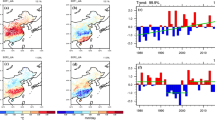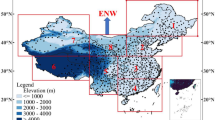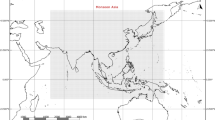Abstract
This study presents the benefit of Copula for modeling correlation of tropical sea surface temperature (SST) and hydroclimatic extremes in Serayu river basin, Indonesia. Precipitation and streamflow dataset from ground-based measurement and sea surface temperature dataset from National Oceanic and Atmospheric Administration (NOAA) extending from 1985 to 2017 were analyzed in this study. Principal Component Analysis (PCA) was employed to extract the leading principal components (PCs) that explain more than 50% of data variance. Linear model and Copula model were utilized to detect tropical regions that possess strong correlation with hydroclimatic extremes. Within these regions, Bayesian Dynamic Linear Model (BDLM) was used to scrutinize the role of regional SST in the tropical regions. The result suggests increasing trend of daily hydroclimatic extremes and decreasing tendency of seasonal extremes over the period of 1985–2014, signifying intense floods and droughts in the study area. Furthermore, while typical regions owing to have powerful link with hydroclimatic extremes are detected from linear model, different regions are produced by Copula model. This indicates that the Copula model complements the linear model, partially due to the ability of Copula model in gathering marginal distribution of the joint variables. Additionally, the larger areas spotted from Copula model strengthen the inference of influence of El Nino Southern Oscillation (ENSO) and Indian Oscillation Dipole (IOD) on hydroclimatic extremes in tropical regions, such as the river basin in this study. Moreover, it is found that the association of hydroclimatic extremes and IOD is stronger after 2007 while opposite feature is observed on ENSO. These findings conclude the benefit of Copula on hydroclimatic extremes analysis, and the method should be applicable for other regions.








Similar content being viewed by others
References
Arnell NW, Lowe JA, Challinor AJ (2019) Osborn TJ (2019) Global and regional impacts of climate change at different levels of global temperature increase. Clim Chang 1553(155):377–391. https://doi.org/10.1007/S10584-019-02464-Z
BNPB (2020) Data informasi Bencana Indonesia (DIBI). http://bnpb.cloud/dibi/beranda. Accessed 8 Oct 2020
Bracken C, Rajagopalan B, Cheng L et al (2016) Spatial Bayesian hierarchical modeling of precipitation extremes over a large domain. Water Resour Res 52:6643–6655. https://doi.org/10.1002/2016WR018768
Casson RJ, Farmer LD (2014) Understanding and checking the assumptions of linear regression: a primer for medical researchers. Clin Experiment Ophthalmol 42:590–596. https://doi.org/10.1111/CEO.12358
Chandimala J, Zubair L (2007) Predictability of stream flow and rainfall based on ENSO for water resources management in Sri Lanka. J Hydrol 335:303–312. https://doi.org/10.1016/J.JHYDROL.2006.11.024
Chen L, Singh VP, Guo S et al (2015) Copula-based method for multisite monthly and daily streamflow simulation. J Hydrol 528:369–384. https://doi.org/10.1016/J.JHYDROL.2015.05.018
Cristiano E, Veldhuis M-C, Van De Giesen N (2017) Spatial and temporal variability of rainfall and their effects on hydrological response in urban areas-a review. Hydrol Earth Syst Sci 21:3859–3878. https://doi.org/10.5194/hess-21-3859-2017
Dabar OA, Camberlin P, Pohl B et al (2021) Spatial and temporal variability of rainfall over the Republic of Djibouti from 1946 to 2017. Int J Climatol 41:2729–2748. https://doi.org/10.1002/JOC.6986
Dadson SJ, Lopez HP, Peng J, Vora S (2019) Hydroclimatic Extremes and Climate Change. Water Sci Policy Manag. https://doi.org/10.1002/9781119520627.CH2
Drees H, Sabourin A (2019) Principal component analysis for multivariate extremes
Durante F, Sempi C (2010) Copula theory: an introduction. Springer, Berlin, pp 3–31
Fischer M, Rust HW, Ulbrich U (2019) A spatial and seasonal climatology of extreme precipitation return-levels: a case study. Spat Stat 34:100275. https://doi.org/10.1016/j.spasta.2017.11.007
Giorgi F, Coppola E, Raffaele F (2018) Threatening levels of cumulative stress due to hydroclimatic extremes in the 21st century. Npj Clim Atmos Sci 11(1):1–9. https://doi.org/10.1038/s41612-018-0028-6
Gudendorf G, Segers J (2010) Extreme-Value Copulas. Springer, Berlin, pp 127–145
Haslinger K, Koffler D, Schöner W, Laaha G (2014) Exploring the link between meteorological drought and streamflow: effects of climate-catchment interaction. Water Resour Res 50:2468–2487. https://doi.org/10.1002/2013WR015051
Hong Y, Adhikari P, Gourley JJ (2013) Flood hazard and disaster. Encycl Earth Sci Ser. https://doi.org/10.1007/978-1-4020-4399-4_138
Jewson S (2020) An alternative to PCA for estimating dominant patterns of climate variability and extremes, with application to U.S. and China Seasonal rainfall. Atmosphere 11:354. https://doi.org/10.3390/ATMOS11040354
Jiang Y, Cooley D, Wehner MF (2020) Principal Component Analysis For Extremes And Application to U.S. Precipitation J Clim 33:6441–6451. https://doi.org/10.1175/JCLI-D-19-0413.1
Jolliffe IT, Cadima J (2016) Principal component analysis: a review and recent developments. Philos Trans R Soc A Math Phys Eng Sci. https://doi.org/10.1098/RSTA.2015.0202
Kazemzadeh M, Hashemi H, Jamali S et al (2021) Linear and Nonlinear Trend Analyzes in Global Satellite-Based Precipitation, 1998–2017. Earth’s Futur 9:e2020EF001835. https://doi.org/10.1029/2020EF001835
Khedun CP, Mishra AK, Singh VP, Giardino JR (2014) A copula-based precipitation forecasting model: Investigating the interdecadal modulation of ENSO’s impacts on monthly precipitation. Water Resour Res 50:580–600. https://doi.org/10.1002/2013WR013763
Kojadinovic I, Yan J (2010) Modeling multivariate distributions with continuous margins using the copula R package. J Stat Softw 34:1–20. https://doi.org/10.18637/jss.v034.i09
Liu X, Li Z, Attarod P (2021) Editorial: understanding hydrological extremes and their impact in a changing climate: observations modeling and attribution. Front Earth Sci. https://doi.org/10.3389/FEART.2020.632186
Lloyd-Hughes B (2013) (2013) The impracticality of a universal drought definition. Theor Appl Climatol 1173(117):607–611. https://doi.org/10.1007/S00704-013-1025-7
Lovino M, García NO, Baethgen W (2014) Spatiotemporal analysis of extreme precipitation events in the Northeast region of Argentina (NEA). J Hydrol Reg Stud 2:140–158. https://doi.org/10.1016/J.EJRH.2014.09.001
Maggioni V, Massari C (2019) Extreme hydroclimatic events and multivariate hazards in a changing environment. Elsevier, Amsterdam
Mai J-F, Scherer M (2014) What are popular families of Copulas? Financ Eng Copulas Explain. https://doi.org/10.1057/9781137346315_4
Marengo JA, Camarinha PI, Alves LM et al (2021) Extreme rainfall and hydro-geo-meteorological disaster risk in 1.5, 2.0, and 4.0°c global warming scenarios: an analysis for Brazil. Front Clim. https://doi.org/10.3389/FCLIM.2021.610433
Martinez-Lopez B, Martinez-Lopez, Benjamin (2020) Non-linear, long-term evolution of sea surface temperature across the World Ocean. In: EGUGA 22546
Miao C, Sun Q, Duan Q, Wang Y (2016) Joint analysis of changes in temperature and precipitation on the Loess Plateau during the period 1961–2011. Clim Dyn 479(47):3221–3234. https://doi.org/10.1007/S00382-016-3022-X
Miniussi A, Marani M (2020) Estimation of daily rainfall extremes through the metastatistical extreme value distribution: uncertainty minimization and implications for trend detection. Water Resour Res 56:e2019WR026535. https://doi.org/10.1029/2019WR026535
Miyan MA (2015) Droughts in Asian least developed countries: vulnerability and sustainability. Weather Clim Extrem 7:8–23. https://doi.org/10.1016/J.WACE.2014.06.003
Myhre G, Alterskjær K, Stjern CW et al (2019) Frequency of extreme precipitation increases extensively with event rareness under global warming. Sci Rep 9:1–10. https://doi.org/10.1038/s41598-019-52277-4
Najib MK, Nurdiati S, Sopaheluwakan A (2021) Copula-based joint distribution analysis of the ENSO effect on the drought indicators over Borneo fire-prone areas. Model Earth Syst Environ 2021:1–10. https://doi.org/10.1007/S40808-021-01267-5
Nelsen RB (2006) An Introduction to Copulas. Springer, New York
Nguyen-Huy T, Deo RC, An-Vo DA et al (2017) Copula-statistical precipitation forecasting model in Australia’s agro-ecological zones. Agric Water Manag 191:153–172. https://doi.org/10.1016/j.agwat.2017.06.010
Ossandón Á, Rajagopalan B, Kleiber W (2021) Spatial-temporal multivariate semi-Bayesian hierarchical framework for extreme precipitation frequency analysis. J Hydrol 600:126499. https://doi.org/10.1016/J.JHYDROL.2021.126499
Pandey PK, Das L, Jhajharia D, Pandey V (2018) Modelling of interdependence between rainfall and temperature using copula. Model Earth Syst Environ 4:867–879. https://doi.org/10.1007/s40808-018-0454-9
Petris G, Petrone S, Campagnoli P (2009) Dynamic linear models with. Springer, Berlin
Porto de Carvalho JR, Assad ED, de Oliveira AF, Silveira Pinto H (2014) Annual maximum daily rainfall trends in the Midwest, southeast and southern Brazil in the last 71 years. Weather Clim Extrem 5–6:7–15. https://doi.org/10.1016/J.WACE.2014.10.001
Puczko K, Jekatierynczuk-Rudczyk E (2020) Extreme hydro-meteorological events influence to water quality of small rivers in urban area: a case study in Northeast Poland. Sci Reports 101(10):1–14. https://doi.org/10.1038/s41598-020-67190-4
Reynolds RW, Rayner NA, Smith TM et al (2002) An Improved in situ and satellite SST analysis for climate. J Clim 15:1609–1625. https://doi.org/10.1175/1520-0442(2002)015%3c1609:AIISAS%3e2.0.CO;2
Sadegh M, Ragno E, AghaKouchak A (2017) Multivariate Copula analysis toolbox (MvCAT): describing dependence and underlying uncertainty using a Bayesian framework. Water Resour Res 53:5166–5183. https://doi.org/10.1002/2016WR020242
Schiermeier Q (2018) Droughts, heatwaves and floods: How to tell when climate change is to blame. Nature 560:20–22. https://doi.org/10.1038/D41586-018-05849-9
Shrestha S, Bae D-H, Hok P et al (2021) (2021) Future hydrology and hydrological extremes under climate change in Asian river basins. Sci Reports 111(11):1–12. https://doi.org/10.1038/s41598-021-96656-2
Siswanto S, van Oldenborgh GJ, van der Schrier G et al (2016) Temperature, extreme precipitation, and diurnal rainfall changes in the urbanized Jakarta city during the past 130 years. Int J Climatol 36:3207–3225. https://doi.org/10.1002/joc.4548
Supari TF, Juneng L, Aldrian E (2017) Observed changes in extreme temperature and precipitation over Indonesia. Int J Climatol 37:1979–1997. https://doi.org/10.1002/joc.4829
Tabari H (2020) Climate change impact on flood and extreme precipitation increases with water availability. Sci Rep 10:1–10. https://doi.org/10.1038/s41598-020-70816-2
Taillon G, Onishi K, Mineshima T, Miyagawa K (2019) Statistical analysis of cavitation erosion impacts in a vibratory apparatus with copulas. In IOP conference series: earth and environmental science, p 240. https://doi.org/10.1088/1755-1315/240/6/062035
Tawn JA (1990) Modelling multivariate extreme value distributions. Biometrika 77:245. https://doi.org/10.2307/2336802
West M, Harrison J (1997) Bayesian forecasting and dynamic models, 2nd edn. Springer, Berlin
Wilks DS (1995) Statistical method in the atmospheric sciences. Academic Press, London
WMO (2021) The atlas of mortality and economic losses from weather, climate and water extremes (1970–2019). WMO, Geneva
WMO (2021) Weather-related disasters increase over past 50 years, causing more damage but fewer deaths. World Meteorological Organization. https://public.wmo.int/en/media/press-release/weather-related-disasters-increase-over-past-50-years-causing-more-damage-fewer. Accessed 28 Sep 2021
Yan J (2007) Enjoy the joy of copulas: with a package copula. J Stat Softw 21:1–21. https://doi.org/10.18637/jss.v021.i04
Yanto LB, Rajagopalan B (2017) Development of a gridded meteorological dataset over Java island, Indonesia 1985–2014. Sci Data 4:170072. https://doi.org/10.1038/sdata.2017.72
Yanto RB, Zagona E (2016) Space-time variability of Indonesian rainfall at inter-annual and multi-decadal time scales. Clim Dyn. https://doi.org/10.1007/s00382-016-3008-8
Yee KC, Suhaila J, Yusof F, Mean FH (2014) Bivariate copula in fitting rainfall data. In: AIP conference proceedings. American Institute of Physics Inc., pp 986–990
Acknowledgements
This research is fully funded by Asia-Pacific Network for Global Change Research (https://doi.org/10.13039/100005536) under Grant Number of CRRP2018-06MY-Yanto.
Author information
Authors and Affiliations
Corresponding author
Ethics declarations
Conflict of interest
The authors declare that they have no known competing financial interests or personal relationships that could have appeared to influence the work reported in this paper.
Additional information
Edited by Dr. Michael Nones (CO-EDITOR-IN-CHIEF).
Rights and permissions
Springer Nature or its licensor (e.g. a society or other partner) holds exclusive rights to this article under a publishing agreement with the author(s) or other rightsholder(s); author self-archiving of the accepted manuscript version of this article is solely governed by the terms of such publishing agreement and applicable law.
About this article
Cite this article
Yanto, Rajagopalan, B. & Regonda, S.K. Linear and copula model for understanding climate drivers of hydroclimatic extremes: a case study of Serayu river basin, Indonesia. Acta Geophys. 72, 1067–1078 (2024). https://doi.org/10.1007/s11600-023-01078-5
Received:
Accepted:
Published:
Issue Date:
DOI: https://doi.org/10.1007/s11600-023-01078-5




